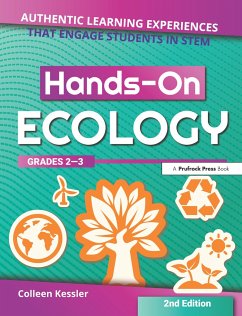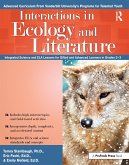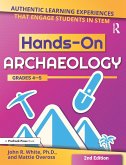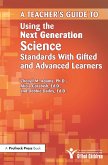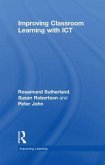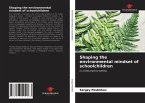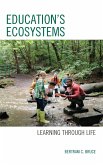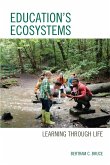Colleen Kessler
Hands-On Ecology
Authentic Learning Experiences That Engage Students in Stem (Grades 2-3)
Colleen Kessler
Hands-On Ecology
Authentic Learning Experiences That Engage Students in Stem (Grades 2-3)
- Broschiertes Buch
- Merkliste
- Auf die Merkliste
- Bewerten Bewerten
- Teilen
- Produkt teilen
- Produkterinnerung
- Produkterinnerung
Hands-On Ecology immerses students in the world of real-life ecologists. Through engaging authentic learning experiences, students will explore ecological habitats while building STEM skills.
Andere Kunden interessierten sich auch für
![Interactions in Ecology and Literature Interactions in Ecology and Literature]() Tamra StambaughInteractions in Ecology and Literature50,99 €
Tamra StambaughInteractions in Ecology and Literature50,99 €![Hands-On Archaeology Hands-On Archaeology]() John R WhiteHands-On Archaeology27,99 €
John R WhiteHands-On Archaeology27,99 €![Teacher's Guide to Using the Next Generation Science Standards with Gifted and Advanced Learners Teacher's Guide to Using the Next Generation Science Standards with Gifted and Advanced Learners]() Cheryll M AdamsTeacher's Guide to Using the Next Generation Science Standards with Gifted and Advanced Learners23,99 €
Cheryll M AdamsTeacher's Guide to Using the Next Generation Science Standards with Gifted and Advanced Learners23,99 €![Improving Classroom Learning with ICT Improving Classroom Learning with ICT]() Rosamund SutherlandImproving Classroom Learning with ICT206,99 €
Rosamund SutherlandImproving Classroom Learning with ICT206,99 €![Shaping the environmental mindset of schoolchildren Shaping the environmental mindset of schoolchildren]() Sergey PostnikovShaping the environmental mindset of schoolchildren61,99 €
Sergey PostnikovShaping the environmental mindset of schoolchildren61,99 €![Education's Ecosystems Education's Ecosystems]() Bertram C. BruceEducation's Ecosystems84,99 €
Bertram C. BruceEducation's Ecosystems84,99 €![Education's Ecosystems Education's Ecosystems]() Bertram C. BruceEducation's Ecosystems45,99 €
Bertram C. BruceEducation's Ecosystems45,99 €-
-
Hands-On Ecology immerses students in the world of real-life ecologists. Through engaging authentic learning experiences, students will explore ecological habitats while building STEM skills.
Hinweis: Dieser Artikel kann nur an eine deutsche Lieferadresse ausgeliefert werden.
Hinweis: Dieser Artikel kann nur an eine deutsche Lieferadresse ausgeliefert werden.
Produktdetails
- Produktdetails
- Verlag: Taylor & Francis Ltd (Sales)
- 2nd edition
- Seitenzahl: 176
- Erscheinungstermin: 15. Juni 2019
- Englisch
- Abmessung: 277mm x 213mm x 15mm
- Gewicht: 431g
- ISBN-13: 9781618218537
- ISBN-10: 1618218530
- Artikelnr.: 54925101
- Herstellerkennzeichnung
- Libri GmbH
- Europaallee 1
- 36244 Bad Hersfeld
- gpsr@libri.de
- Verlag: Taylor & Francis Ltd (Sales)
- 2nd edition
- Seitenzahl: 176
- Erscheinungstermin: 15. Juni 2019
- Englisch
- Abmessung: 277mm x 213mm x 15mm
- Gewicht: 431g
- ISBN-13: 9781618218537
- ISBN-10: 1618218530
- Artikelnr.: 54925101
- Herstellerkennzeichnung
- Libri GmbH
- Europaallee 1
- 36244 Bad Hersfeld
- gpsr@libri.de
Colleen Kessler is an Elementary Gifted Intervention Specialist in Northeast Ohio. She currently teaches second- and third-grade gifted students in Pepper Pike, OH. Kessler earned her bachelor's degree in Elementary Education from Cleveland State University in 1997. She earned a master's degree in Gifted Education from Kent State University in 2002. Kessler believes the best education is fun, motivating, and engaging for students and strives to provide such an environment for her students. She has been teaching for 7 years. Kessler lives in Twinsburg, OH, with her husband and son.
Introduction Chapter 1: Preparing the Essentials Activity 1: An Ecology
Dictionary Activity 2: Creating a Field Journal Activity 3: Building an
Ecology Tool Kit Activity 4: Interviewing a Naturalist Activity 5: A Day in
the Life of an Ecologist Chapter 2: What Is an Ecosystem Activity 6:
Providing the Essentials Activity 7: Producing Nature¿s Energy Activity 8:
Food Web Activity 9: Decomposition Activity 10: Worm Habitat Activity 11:
Creating Mini-Ecosystems Chapter 3: A Local Ecosystem Activity 12: Mapping
Your Local Activity 13: Ecosystems Within Ecosystems Activity 14: A Square
Yard Activity 15: Soil Quality Activity 16: Understanding the Carbon Cycle
Activity 17: Water Quality Chapter 4: Studying Populations Activity 18:
Animal Populations Activity 19: Plant Populations Activity 20: Adaptations
Chapter 5: Human Impact on the Environment Activity 21: Erosion Activity
22: Air Quality Activity 23: Acid Rain Activity 24: Local Water Pollution
Activity 25: Global Climate Chapter 6: Making a Contribution to
Conservation Activity 26: Earth Day Internet Scavenger Hunt Activity 27:
Hosting a Speaker or an Assembly Activity 28: Writing and Performing
Activity 29: Tree-Planting Event Activity 30: Launching a Poster Campaign
Activity 31: Litter Pick-Up Day Activity 32: Conservation Penny Drive
Activity 33: Recycling Project Activity 34: Composting Chapter 7: Creating
a Wildlife Garden Activity 35: Making a Contract With Nature Activity 36:
Building a Habitat Pile Activity 37: This Place Is for the Birds Activity
38: Bee Boxes and Spider Spaces Appendix: Resources About the Author Next
Generation Science Standards Alignment
Dictionary Activity 2: Creating a Field Journal Activity 3: Building an
Ecology Tool Kit Activity 4: Interviewing a Naturalist Activity 5: A Day in
the Life of an Ecologist Chapter 2: What Is an Ecosystem Activity 6:
Providing the Essentials Activity 7: Producing Nature¿s Energy Activity 8:
Food Web Activity 9: Decomposition Activity 10: Worm Habitat Activity 11:
Creating Mini-Ecosystems Chapter 3: A Local Ecosystem Activity 12: Mapping
Your Local Activity 13: Ecosystems Within Ecosystems Activity 14: A Square
Yard Activity 15: Soil Quality Activity 16: Understanding the Carbon Cycle
Activity 17: Water Quality Chapter 4: Studying Populations Activity 18:
Animal Populations Activity 19: Plant Populations Activity 20: Adaptations
Chapter 5: Human Impact on the Environment Activity 21: Erosion Activity
22: Air Quality Activity 23: Acid Rain Activity 24: Local Water Pollution
Activity 25: Global Climate Chapter 6: Making a Contribution to
Conservation Activity 26: Earth Day Internet Scavenger Hunt Activity 27:
Hosting a Speaker or an Assembly Activity 28: Writing and Performing
Activity 29: Tree-Planting Event Activity 30: Launching a Poster Campaign
Activity 31: Litter Pick-Up Day Activity 32: Conservation Penny Drive
Activity 33: Recycling Project Activity 34: Composting Chapter 7: Creating
a Wildlife Garden Activity 35: Making a Contract With Nature Activity 36:
Building a Habitat Pile Activity 37: This Place Is for the Birds Activity
38: Bee Boxes and Spider Spaces Appendix: Resources About the Author Next
Generation Science Standards Alignment
Introduction Chapter 1: Preparing the Essentials Activity 1: An Ecology
Dictionary Activity 2: Creating a Field Journal Activity 3: Building an
Ecology Tool Kit Activity 4: Interviewing a Naturalist Activity 5: A Day in
the Life of an Ecologist Chapter 2: What Is an Ecosystem Activity 6:
Providing the Essentials Activity 7: Producing Nature¿s Energy Activity 8:
Food Web Activity 9: Decomposition Activity 10: Worm Habitat Activity 11:
Creating Mini-Ecosystems Chapter 3: A Local Ecosystem Activity 12: Mapping
Your Local Activity 13: Ecosystems Within Ecosystems Activity 14: A Square
Yard Activity 15: Soil Quality Activity 16: Understanding the Carbon Cycle
Activity 17: Water Quality Chapter 4: Studying Populations Activity 18:
Animal Populations Activity 19: Plant Populations Activity 20: Adaptations
Chapter 5: Human Impact on the Environment Activity 21: Erosion Activity
22: Air Quality Activity 23: Acid Rain Activity 24: Local Water Pollution
Activity 25: Global Climate Chapter 6: Making a Contribution to
Conservation Activity 26: Earth Day Internet Scavenger Hunt Activity 27:
Hosting a Speaker or an Assembly Activity 28: Writing and Performing
Activity 29: Tree-Planting Event Activity 30: Launching a Poster Campaign
Activity 31: Litter Pick-Up Day Activity 32: Conservation Penny Drive
Activity 33: Recycling Project Activity 34: Composting Chapter 7: Creating
a Wildlife Garden Activity 35: Making a Contract With Nature Activity 36:
Building a Habitat Pile Activity 37: This Place Is for the Birds Activity
38: Bee Boxes and Spider Spaces Appendix: Resources About the Author Next
Generation Science Standards Alignment
Dictionary Activity 2: Creating a Field Journal Activity 3: Building an
Ecology Tool Kit Activity 4: Interviewing a Naturalist Activity 5: A Day in
the Life of an Ecologist Chapter 2: What Is an Ecosystem Activity 6:
Providing the Essentials Activity 7: Producing Nature¿s Energy Activity 8:
Food Web Activity 9: Decomposition Activity 10: Worm Habitat Activity 11:
Creating Mini-Ecosystems Chapter 3: A Local Ecosystem Activity 12: Mapping
Your Local Activity 13: Ecosystems Within Ecosystems Activity 14: A Square
Yard Activity 15: Soil Quality Activity 16: Understanding the Carbon Cycle
Activity 17: Water Quality Chapter 4: Studying Populations Activity 18:
Animal Populations Activity 19: Plant Populations Activity 20: Adaptations
Chapter 5: Human Impact on the Environment Activity 21: Erosion Activity
22: Air Quality Activity 23: Acid Rain Activity 24: Local Water Pollution
Activity 25: Global Climate Chapter 6: Making a Contribution to
Conservation Activity 26: Earth Day Internet Scavenger Hunt Activity 27:
Hosting a Speaker or an Assembly Activity 28: Writing and Performing
Activity 29: Tree-Planting Event Activity 30: Launching a Poster Campaign
Activity 31: Litter Pick-Up Day Activity 32: Conservation Penny Drive
Activity 33: Recycling Project Activity 34: Composting Chapter 7: Creating
a Wildlife Garden Activity 35: Making a Contract With Nature Activity 36:
Building a Habitat Pile Activity 37: This Place Is for the Birds Activity
38: Bee Boxes and Spider Spaces Appendix: Resources About the Author Next
Generation Science Standards Alignment

